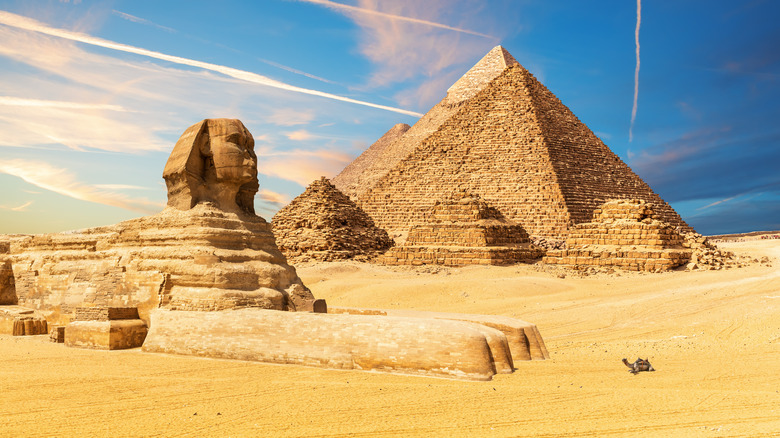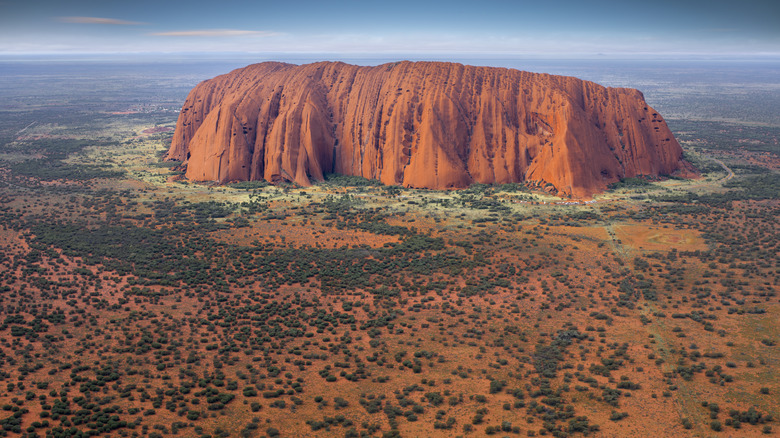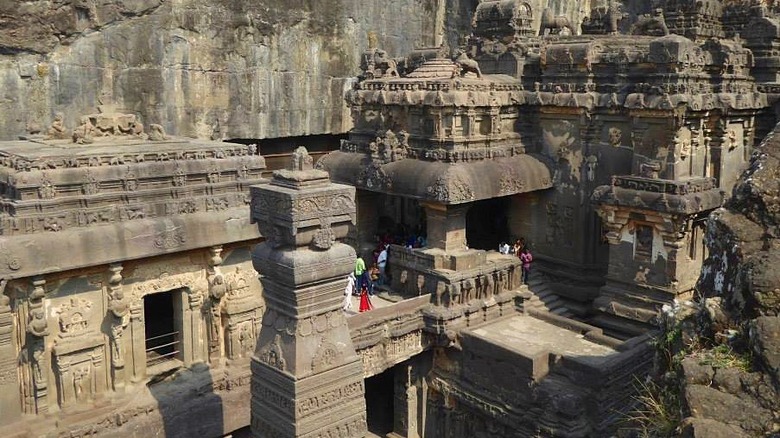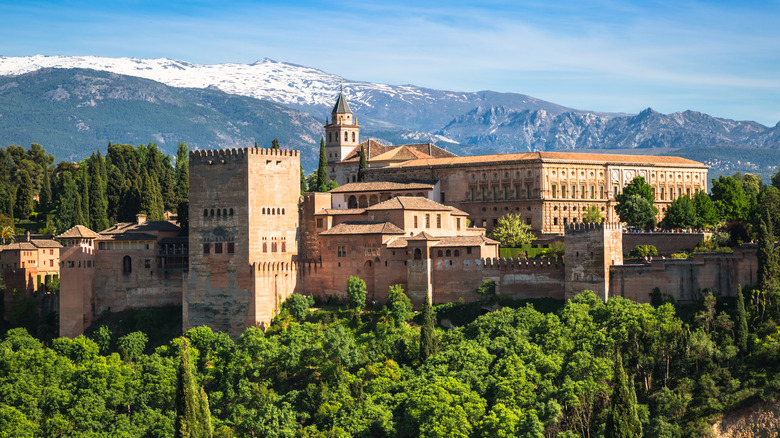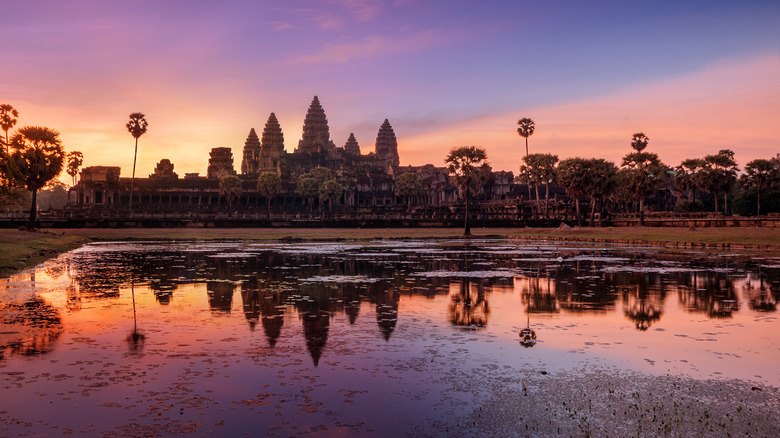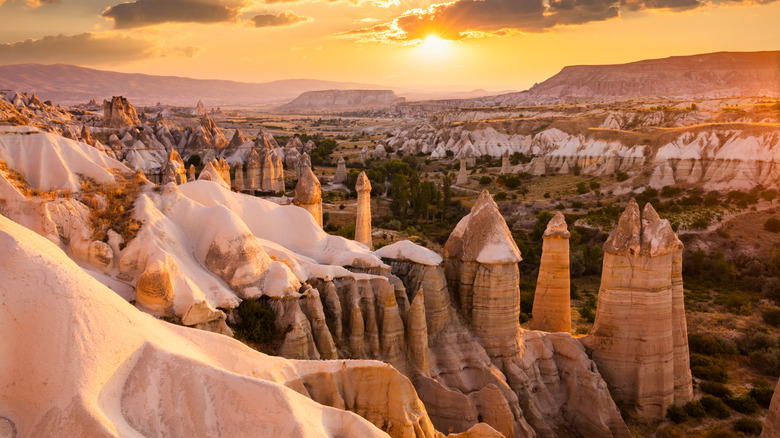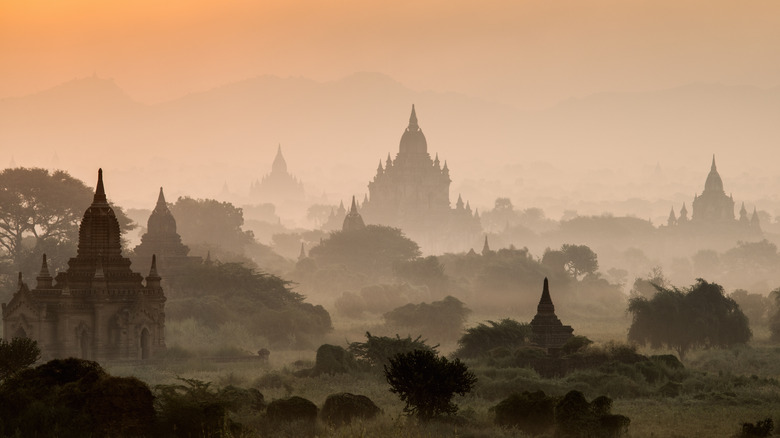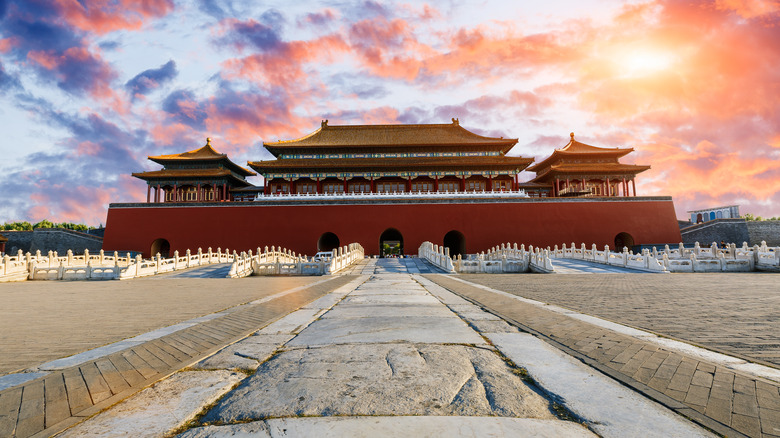12 Destinations And Attractions That Should Absolutely Be Considered Wonders Of The World
The original list of Seven Wonders of the Ancient World was created in 225 BCE by Philo of Byzantium, an ancient Greek engineer and master of mechanics. Of the seven structures on his list, only one — the Great Pyramid of Giza — has stood the test of time. In 2007, a private organization known as the New 7 Wonders Foundation strived to modernize this terribly outdated list. It did so via a worldwide poll involving millions of global voters. The outcome was the New Seven Wonders of the World, including the Great Wall of China, the Taj Mahal, Machu Picchu, and more. The organization also chose a New 7 Wonders of Nature, containing natural attractions ranging from Iguazu Falls to Komodo Island. This updated — or at least added to — the unofficial widely-recognized Seven Natural Wonders of the World. Clearly, there is no shortage awe-inspiring locations, and we're here to highlight even more you may not have considered before.
It's hard to disagree with any of these lists, but with so many structures and natural wonders on our stunning planet, it's hard to just stop there. With that in mind, we've compiled yet another list of other destinations and attractions absolutely worthy of being considered wonders. From ancient structures to sprawling salt flats, these places deserve a spot on your bucket list.
Uluru / Ayres Rock, Australia
Uluru, to give it its Anangu name, is one of the world's most mysterious places. It's a striking sandstone monolith and a geological marvel that defies explanation. The Anangu are this sacred rock's indigenous owners. The name Uluru roughly translates to "great pebble" in English. William Gosse, who was an English explorer and surveyor, became the first non-indigenous person to witness this extraordinary anomaly in 1873. He named it Ayres Rock, a name that stuck until 1993 when it was officially given the dual title of Uluru/Ayers Rock.
At 2.2 miles long, 1.2 miles wide, and standing at a height of 1,141 feet with an almost perfectly level summit, Uluru imposes on this otherwise flat landscape. The rock's iron minerals contribute to it majestically changing color throughout the day. In the early morning, it appears like a soft red, almost pink color. As the sun moves across the sky, it changes to flaming red, then to a bright golden orange, before turning back to red again with intense shadows. As the sun sinks over the horizon, the rock's colors fade into dark purples and blues.
It's a unique formation comparable to nowhere else on the planet. However, as of 2019, you can no longer climb to the summit. This is down to the Anangu's traditional law that forbids it, in addition to a concern for the safety of travelers at the top of the blustery peak. Luckily, standing in awe of this prehistoric monolith is more than enough for any traveler to the region.
Ellora Caves, India
A trip to the city of Aurangabad in India may not be a particularly memorable experience; however, sign up for a tour or find your way independently to the Ellora Caves situated in the countryside to the northwest, and it'll be a worthwhile venture. These rock-cut temples were carved out of a sheer basalt cliff between 200 BCE to 1,000 CE and span a length of 1.2 miles. The 12 older southern temples are Buddhist caves, while the 17 central temples are dedicated to Hinduism. The five newer temples in the north of the complex represent Jainism, a relatively minor, yet ancient, religion in the country. Then there is Kailasa Temple.
Kailasa Temple is cave number 16. It was cut out from a single rock in 760 CE from top to bottom with nothing more than hammers and chisels. It is 100 feet (30.5 meters) high, 300 feet (92 meters) long and 175 feet (53 meters) wide, making it the world's largest monolithic structure. It was built as a representation of Mount Kailash in Tibet, said to be the abode of the Hindu deity, Shiva. The elaborate details of the cave have survived the years and remain largely intact with a splendor that's hard to match.
However, a trip to Aurangabad doesn't end with the Ellora Caves. Some 50 miles to the northeast, you'll find another set of UNESCO-protected caves. The Ajanta Caves are a stunning collection of Buddhist rock-cut temples and another reason that makes the heat and noise of Aurangabad well worth the effort. You may even enjoy these sites more than the country's official wonder, the Taj Mahal.
Salar de Uyuni, Bolivia
11,975 feet (3,650 meters) above sea level in the Altiplano region of western Bolivia is the incredible Salar de Uyuni, the world's largest salt flat. It covers an approximate area of 3,861 square miles and is filled with an educated guess of 10 billion tonnes of salt. Here, everything is pure white, like snow, which contrasts against the deep blue sky. But, during the wet season, water accumulates on the surface to reflect the dramatic colors of the heavens perfectly in a mesmerizing mirror effect. It's one of the world's most unique landscapes and one that any visitor to the area simply cannot miss. The clouds and color create an astonishing horizonless illusion and gift visitors with some unimaginable Instagram moments.
Flocks of flamingos call this salt flat home, especially during the wet summer months before they escape the bitter cold winter. Their bright pink color contrasts against the velvety blue of the high-altitude sky, which reflects off the surface water to create a photographer's dream. The Altiplano is also home to conservative indigenous communities who have preserved their cultural identities for hundreds of years. However, as the flat holds an estimated 17% of the planet's lithium, a metal essential in the production of batteries, fears are growing that the indigenous people of the area are benefitting little from the mining while being left to handle the environmental impact alone.
The Acropolis, Greece
The Acropolis is a UNESCO World Heritage Site in Athens, Greece, and represents the pinnacle of ancient Greek civilization. It dates back to the 5th Century BCE and has stood proudly over the capital for over 2,500 years. It's a masterpiece of Greek architecture and remains well-preserved despite the hordes of tourists who visit every year.
Building began all those centuries ago when Pericles, the Athenian statesman responsible for the development of democracy, began a considerable construction initiative. This formed the base of the Athenian empire. However, his vision was not fully realized upon his death and further additions were made by the Romans in later years.
The Parthenon is the most recognizable building in the Acropolis. It dominates the Athens skyline and has come to represent the origin of intellectual and philosophical ideas. It has stood above the city as if reflecting on those cultural achievements of ancient Greece ever since. In fact, you could say it is a monument dedicated to the legacy of Greek culture in Western society. However, Greece has a fantastic variety of other ancient sites that are also well worth a visit.
The Galapagos Islands, Ecuador
In terms of ecological significance, the Galapagos is one of the most unique natural environments on the planet and a destination of a lifetime. Of the abundance of reptiles and land mammals on the islands, 97% are endemic. Of the land birds, it's 80%, while 30% of all plant life and 20% of its marine animals can be found nowhere else but there. The island is renowned around the world for its resident giant tortoises, which grow to an average of 4.9 feet in height with a weight of as much as 880 pounds. Other endemic species on the islands include the Galapagos fur seal, the flightless cormorant, and the marine iguana.
The islands were, of course, famously studied by Charles Darwin and heavily influenced his theory of evolution. His findings gave the islands a significant historical legacy and have had a profound impact on science, as well as our understanding of the natural world. However, endemic species are not the only natural wonders to be found here. The islands are also a visually stunning landscape of crystal-clear water, pristine beaches, and otherworldly volcanic formations. In fact, the volcanoes are still active, with one recent eruption occurring in 2009 on the island of Fernandina. You can still see plumes of steam and gas billowing out of the volcano at regular intervals.
The Alhambra, Spain
As a masterpiece of Islamic architecture, the Alhambra in Granada, Spain is a UNESCO World Heritage Site and one of the country's most iconic landmarks. Built during the 13th and 14th centuries, this well-preserved fortress and palace complex is an example of intricate craftsmanship and detailed art. It exemplifies the Moorish talent for aesthetics with its complex geometric designs, spacious courtyards, and lush gardens.
Sabika Hill, upon which this grand creation sits, is a verdant oasis thanks to ornate fountains, tranquil pools, and intricate channels, which contribute greatly to the serene ambiance and overall beauty of the attraction. The Darro River supplies the entire complex with nurturing water via an irrigation canal. Some noteworthy areas include the Patio de los Arrayanes, known for its reflective pool, and the Royal Baths, a rare example of a medieval Islamic bathhouse. It also nourishes the nearby Generalife, a serene royal retreat and one of the oldest surviving examples of a Moorish garden. This palace offers a design of simplicity and elegance, which contrasts the rest of the Alhambra complex beautifully.
Angkor Wat, Cambodia
While Angkor Wat alone is enough to satisfy even the most wonder-hungry traveler, a visit to this mighty monument is just the tip of the iceberg. Angkor was the ancient capital of the Khmer Empire and the Angkor Archaeological Park is a vast site that takes at least two full days just to see the main attractions. Angkor Wat, the largest religious complex the world has ever seen, is the premier draw. The complex is around 400 acres in size, and with its intricate carvings and huge stone structures, it's the best-preserved building in the park and a prime example of Khmer architecture. The temple was built in the 12th century by King Suryavarman II, and its imposing silhouette of three stupa-like tiered towers against the color-drenched morning sky is one of the most enduring sites you will see in Southeast Asia.
The temple is a globally recognized structure and is even featured on the Cambodian national flag. However, there are many other sites in the park that are easily classed as unmissable and perhaps even wonders in their own right. The multitude of imposing, yet serene, stone faces that tower above you as you first approach the Bayon in the ancient city of Angkor Thom is an unforgettable moment. Likewise are the remarkably well-preserved carvings you'll marvel at when you get lost exploring the maze of corridors and galleries at Preah Khan. Then there is Ta Phrom, where you can bear witness to the jungle claiming man-made structures as its own.
Banff National Park, Canada
In terms of North American national parks, it doesn't get much more stunning than Banff National Park in Canada. With its landscapes of towering peaks, turquoise lakes, and imposing glaciers, it's no wonder the Canadians chose it as their first national park. Standing at 11,850 feet, Mount Forbes is the park's tallest peak. However, this is debated, as it was recently discovered that the summit of Mount Assiniboine crosses the park boundary and beats Mount Forbes by 6 meters. Athabasca Glacier is the most accessible of the 1,000 or so within the park borders. This spectacular sight is just about 4 miles in length, despite the fact that it has been shrinking for 125 years. Other natural features in the area are an abundance of hot springs, with the most accessible being the Banff Upper Hot Springs, just a short drive out of Banff town.
The park is also home to a diverse range of wildlife, including grizzlies, wolves, elks, and hundreds of species of birds. Furthermore, the area has been home to Indigenous peoples, such as the Nakoda, Blackfoot, and Tsuut'ina Nations, for over 10,000 years. These groups had comprehensive trade routes in place long before Europeans set sail for the continent and used the Banff National Park area seasonally with interconnected trade networks.
Cappadocia, Turkey
Cappadocia's combination of natural rock formations and human-made structures creates a visually striking and unique vista. This area of Turkey is renowned for its otherworldly landscapes characterized by unique geological formations, including valleys and canyons formed through millions of years of tectonic activity, volcanic eruptions, and erosion. Rock pillars, known as fairy chimneys, thanks to their fantastical conical spires, add to a surreal landscape that wouldn't be out of place in a "Lord of the Rings" movie.
The area is also known for its underground cities. There are over 200 of them, with Derinkuyu and Kaymakli the most well-known and visited. There is evidence that the Hittites may have begun work on Derinkuyu with the oldest known written reference to underground dwellings in the area dating back to 370 BCE. However, it's well documented that Christians sought refuge there from Roman persecution in the 4th Century CE. With fascinating attractions like this, restaurants, guest houses, and cafes carved from the rock, and dramatic hot air balloon tours sweeping the entire area, it's no wonder a visit to this wonder is considered a once-in-a-lifetime vacation.
Bagan, Myanmar
While Bagan may not be as universally recognizable as other attractions on this list, anyone who has been there will tell you that it very much warrants a wonder status. Situated on the banks of the Irrawaddy River, this ancient city is home to thousands of temples, stupas, and monasteries contained within a 30-square-mile plain. These buildings date back to between the 9th and 13th centuries, the height of the Pagan Empire. Most are well-preserved, although some have taken a bit of damage at the hands of natural events. A 6.8 magnitude earthquake in 2016, for example, caused damage to many monuments. However, the worst of it reportedly affected modern restorations the military rulers of Myanmar had undertaken.
Some of the more popular temples include Dhammayangyi Temple, the largest in this archaeological zone. It was built in the 12th century and is visible from all parts of Bagan, but has a somewhat cruel history. According to legend, it was built to atone for King Narathu's sins, who was responsible for the murders of several of his family members. Another is the Ananda Temple, which houses four golden Buddhas, while Thatbyinnyu Temple is the tallest in the park at 216.5 feet and exemplifies Burmese architecture and art. It was one of the structures affected by the 2016 earthquake and has been the subject of restoration efforts.
Like Angkor Wat in Cambodia and Capadoccia in Turkey, the best way to see this grand spectacle is to take to the air in one of the many hot air balloons for a sight you won't be able to describe with just plain old words. However, any trip to Myanmar takes consideration. With an unstable political situation, the pros and cons of visiting are open to debate.
Serengeti National Park, Tanzania
Meanwhile, in Africa, the Serengeti National Park continues to support a rich variety of wildlife. The so-called "big five" of lion, leopard, elephant, buffalo, and rhinoceros all reside here in this breathtaking landscape of vast savannahs, rolling grasslands, and iconic acacia trees. It's a UNESCO World Heritage Site and has been a role model in wildlife protection and conservation practices for decades. It's here you must come to witness those "Attenborough moments" of two million migrating wildebeest, zebras, and gazelles navigating crocodile-infested waters and other perilous pitfalls. It is one of the most significant ecological events in the world, and it unfolds between the months of July and October.
On top of its 95 mammal species, 550 species of bird also call this park home. Silhouetted against stunning African sunsets, the flora and fauna of the Serengeti National Park is the main draw and the most significant contribution to this natural wonder. It may not be a budget vacation, but a trip to see this Eden-like paradise delivers iconic memories that are impossible to forget.
The Forbidden City, China
It's baffling that any country would seek to destroy its own cultural heritage, but that is what happened during the Chinese Cultural Revolution between 1966 and 1976. In an effort to eliminate old customs, culture, habits, and ideas (the four olds), the revolution did everything it could to dispose the country of its antiques, historical buildings, religious centers, and artwork. Thankfully, and perhaps due to a faint whiff of tourist dollars, many stunning buildings did survive those traumatic years. Among them was the incredible UNESCO World Heritage Site, the Forbidden City.
Also known as the Palace Museum, the Forbidden City was the center of cultural and political heritage in imperial China. It was constructed between 1406 and 1420 with Feng Shui and ancient Chinese cosmology at the heart of its design, and it covered the rule of 24 emperors from the Ming and Qing dynasties. The site spreads across 180 acres and contains almost 1,000 buildings. And according to legend, there are a total of 9,999 rooms among these resplendent structures. While the reality is somewhat fewer, these rooms do house ancient Chinese artwork and royal furniture in almost perfectly-preserved buildings that showcase Chinese symbolism and craftsmanship in intricate detail.
